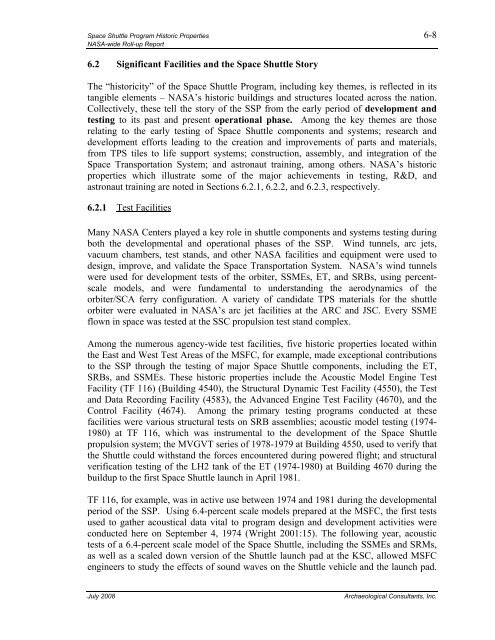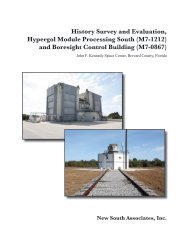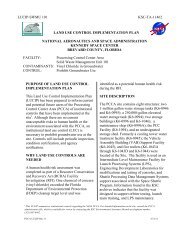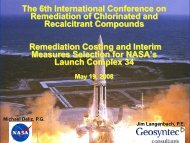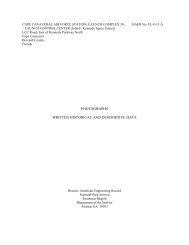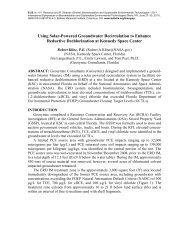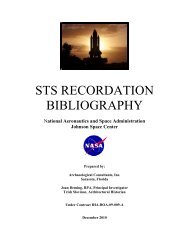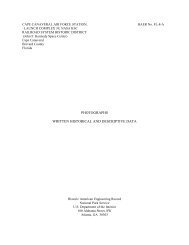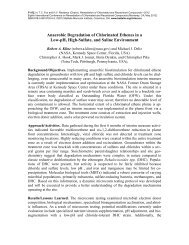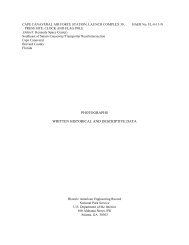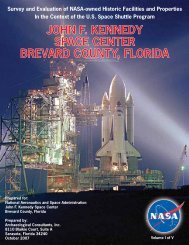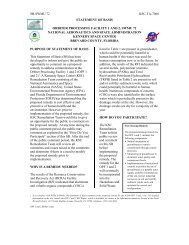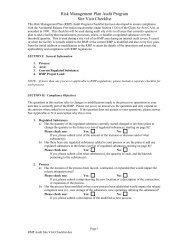Part II - Environmental Program at KSC - NASA
Part II - Environmental Program at KSC - NASA
Part II - Environmental Program at KSC - NASA
Create successful ePaper yourself
Turn your PDF publications into a flip-book with our unique Google optimized e-Paper software.
Space Shuttle <strong>Program</strong> Historic Properties 6-8<strong>NASA</strong>-wide Roll-up Report6.2 Significant Facilities and the Space Shuttle StoryThe “historicity” of the Space Shuttle <strong>Program</strong>, including key themes, is reflected in itstangible elements – <strong>NASA</strong>’s historic buildings and structures loc<strong>at</strong>ed across the n<strong>at</strong>ion.Collectively, these tell the story of the SSP from the early period of development andtesting to its past and present oper<strong>at</strong>ional phase. Among the key themes are thoserel<strong>at</strong>ing to the early testing of Space Shuttle components and systems; research anddevelopment efforts leading to the cre<strong>at</strong>ion and improvements of parts and m<strong>at</strong>erials,from TPS tiles to life support systems; construction, assembly, and integr<strong>at</strong>ion of theSpace Transport<strong>at</strong>ion System; and astronaut training, among others. <strong>NASA</strong>’s historicproperties which illustr<strong>at</strong>e some of the major achievements in testing, R&D, andastronaut training are noted in Sections 6.2.1, 6.2.2, and 6.2.3, respectively.6.2.1 Test FacilitiesMany <strong>NASA</strong> Centers played a key role in shuttle components and systems testing duringboth the developmental and oper<strong>at</strong>ional phases of the SSP. Wind tunnels, arc jets,vacuum chambers, test stands, and other <strong>NASA</strong> facilities and equipment were used todesign, improve, and valid<strong>at</strong>e the Space Transport<strong>at</strong>ion System. <strong>NASA</strong>’s wind tunnelswere used for development tests of the orbiter, SSMEs, ET, and SRBs, using percentscalemodels, and were fundamental to understanding the aerodynamics of theorbiter/SCA ferry configur<strong>at</strong>ion. A variety of candid<strong>at</strong>e TPS m<strong>at</strong>erials for the shuttleorbiter were evalu<strong>at</strong>ed in <strong>NASA</strong>’s arc jet facilities <strong>at</strong> the ARC and JSC. Every SSMEflown in space was tested <strong>at</strong> the SSC propulsion test stand complex.Among the numerous agency-wide test facilities, five historic properties loc<strong>at</strong>ed withinthe East and West Test Areas of the MSFC, for example, made exceptional contributionsto the SSP through the testing of major Space Shuttle components, including the ET,SRBs, and SSMEs. These historic properties include the Acoustic Model Engine TestFacility (TF 116) (Building 4540), the Structural Dynamic Test Facility (4550), the Testand D<strong>at</strong>a Recording Facility (4583), the Advanced Engine Test Facility (4670), and theControl Facility (4674). Among the primary testing programs conducted <strong>at</strong> thesefacilities were various structural tests on SRB assemblies; acoustic model testing (1974-1980) <strong>at</strong> TF 116, which was instrumental to the development of the Space Shuttlepropulsion system; the MVGVT series of 1978-1979 <strong>at</strong> Building 4550, used to verify th<strong>at</strong>the Shuttle could withstand the forces encountered during powered flight; and structuralverific<strong>at</strong>ion testing of the LH2 tank of the ET (1974-1980) <strong>at</strong> Building 4670 during thebuildup to the first Space Shuttle launch in April 1981.TF 116, for example, was in active use between 1974 and 1981 during the developmentalperiod of the SSP. Using 6.4-percent scale models prepared <strong>at</strong> the MSFC, the first testsused to g<strong>at</strong>her acoustical d<strong>at</strong>a vital to program design and development activities wereconducted here on September 4, 1974 (Wright 2001:15). The following year, acoustictests of a 6.4-percent scale model of the Space Shuttle, including the SSMEs and SRMs,as well as a scaled down version of the Shuttle launch pad <strong>at</strong> the <strong>KSC</strong>, allowed MSFCengineers to study the effects of sound waves on the Shuttle vehicle and the launch pad.July 2008Archaeological Consultants, Inc.


